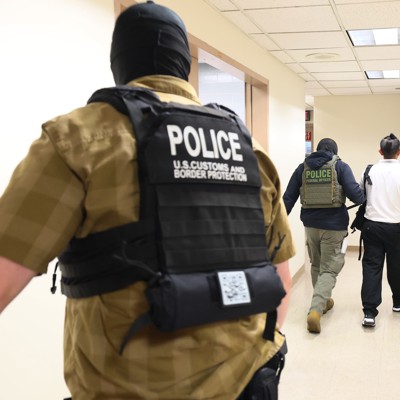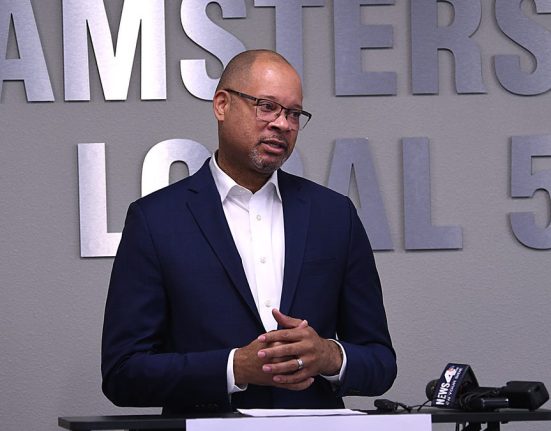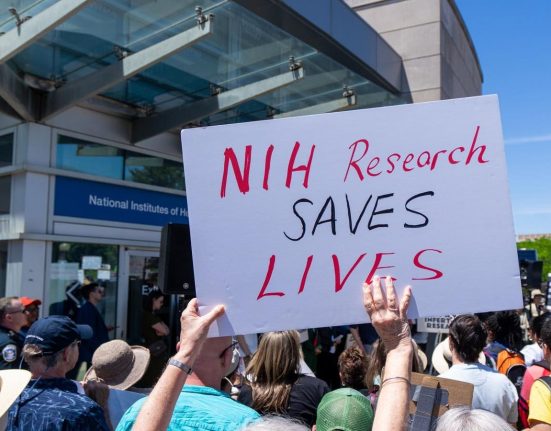Administration officials express confidence they can transform federal agencies through unprecedented hiring, even as they remain realistic about the challenges ahead.
Before President Trump can fulfill perhaps his most salient and visible promise—to conduct mass deportations that force millions of immigrants out of the country and tighten the nation’s grip on its borders so no one can get through them unexpectedly—he needs people.
Ramped up immigration raids and unusual law enforcement deployments are already underway and drawing widespread attention, but to truly fulfill his vision, the administration will need tens of thousands of new agents and officers nationwide.
So congressional Republicans passed the One Big Beautiful Act, which, among its many provisions, provides the Homeland Security Department and other key federal law enforcement agencies with nearly $16 billion for staffing alone. The accompanying hiring plans promise to transform the component agencies into behemoths with prodigious and unparalleled reach—if they can actually convince the people to come work for them.
Customs and Border Protection got $4 billion to hire 8,500 employees, while Immigration and Customs Enforcement received $8 billion to triple its workforce by hiring 10,000 officers and agents. The Bureau of Prisons received $3 billion for staffing.
The Big Beautiful Bill won approval after months of negotiations, last-minute handwringing and a series of dramatic turns that cast significant doubt on its ultimate passage. Jason Owens, a longtime Border Patrol official who served as chief of the agency under President Biden and as its chief operating officer through March, when he retired, said the biggest challenges are still ahead.
“It’s not just as simple as funding the position,” Owens said. “That’s actually the easy part.”
There are reasons for the administration to be hopeful it can reach its destination of remade agencies with surges of new staffing, eight current and former Trump administration and long-time career officials told Government Executive in interviews, but the path to get there is littered with roadblocks and pitfalls that it must avoid. Even when some agencies previously received authorization and funding to hire, they failed to do so in significant numbers.
The jobs are difficult and often located in remote, inclement areas. The hiring process is long and difficult. Potential bottlenecks include background checks and training capacity. Small towns with Border Patrol outposts have limited resources to house and accommodate hundreds or thousands of agents flooding their communities all at once. Owens noted that after extensive onboarding and training processes, employees must learn the ropes of their new communities, including how to navigate broad swaths of desert areas, who the key players in the community are and what cartels control which areas.
A slow build
Andrea Bright, CBP’s assistant commissioner for human resources, said the agency will complete its hiring in 2028. The projected staffing is possible, she said, due to investments made over the last few administrations spanning both parties. That has included improving marketing and advertising, deploying data analytics to determine where in the process CBP has previously lost applicants and enabling potential hires to complete multiple steps in the process simultaneously. The agency also now has full-time recruiters, whereas in Trump’s first term those employees those employees often handled recruiting on top of their normal duties.
“We’ve been building up to this,” Bright said. “We’ve been building our capacity over the last few years.”
Bright, a longtime career HR executive who has served at CBP for six years after more than two decades at the Office of Personnel Management, expressed optimism that the agency’s goals are achievable, but said her biggest concern is the unknown.
“Anything could change,” she said, noting the agency is “at the mercy of applicants” and their interest could change with the ebbs and flows of the economy.
Early returns show some positive signs for the administration. ICE recently boasted it has received 100,000 job applications. CBP has seen a surge in applicants. The rate at which applicants are onboarded, however, has barely moved.
Between May and June of this year, the agency received about 50,000 applications for law enforcement positions, a nearly 40% jump from the same period last year. About 1,200 of those applicants were hired, including 547 Border Patrol agents, a significant jump from the 720 hires it made in the same three months of 2024. Still, CBP will need to significantly ramp up its hiring pace to meet its goals after accounting for attrition.

Ron Vitiello, a former Border Patrol chief, acting deputy commissioner of CBP and acting ICE director who now serves as a senior advisor at CBP, acknowledged his agency must confront several challenges likely to arise.
He noted it was “not trivial” that CBP officers and agents must take a polygraph exam. Historically, more than 75% of applicants have failed that test. Congress instituted the polygraph requirement for CBP’s law enforcement positions in 2010 after a rapid buildup of Border Patrol personnel during the George W. Bush administration led to widespread misconduct at the agency.
Vitiello also called the remote nature of many of the areas that Border Patrol personnel work an “historical challenge.”
Owens, the former border chief, said the agency’s positions are “not as desirable as some of what the other agencies might offer.”
“If they don’t want to go there,” he said, of the small and often isolated towns to which agents must move, “they’ll just turn down the job.” Or, he said, employees may join to get various recruitment incentives but decide it is not worth sticking around once that spigot runs dry.
In addition to the new analytics and recruiting strategies deployed by the Trump administration, the hiring agencies are turning to a more tried-and-true approach: offering more money. ICE has offered signing bonuses of up to $50,000 and expanded student loan repayment. Bright at CBP noted her agency has offered recruitment bonuses of up to $30,000. Both agencies are also incentivizing recently retired employees to rejoin and ICE has removed its age caps for staff to serve.
ICE will receive $858 million for bonuses, while CBP will get $285 million. The money, however, is unlikely to serve as a cure-all. That is, in part, because the offerings are neither new nor unique.
“We have had a really rough time hiring in law enforcement in general,” said Mat Silverman, president of the Federal Law Enforcement Officers Association. “Everywhere you look they are offering bonuses.”
Despite Border Patrol’s bonus offers that have been in place for several years, it failed to reach its hiring goals from fiscal years 2021 through 2024. The number of authorized agents rose from 19,000 to 22,000 in that period, but the actual number of agents employed declined.
In his first term, Trump vowed to ramp up the border security workforce and his administration signed a contract worth up to $300 million to help it bring on 7,500 border personnel, but canceled it after it managed to hire just 15 employees. ICE under Trump solicited vendors for a similar contract, but canceled it before it got off the ground. Lawmakers for years were had to claw back money appropriated for CBP hiring after the agency failed to meet its targets.
Tony Pham, a former DHS official who served as acting head of ICE in 2020, said the agency can expect better results this time not just because of the additional funds, the direct-hire authority that will allow the agency to cut through some of the normal red tape, and tapping into retirees, but also because of a change in the general environment.
“I feel emboldened this time around,” said Pham, who now serves as a senior fellow at the American First Policy Institute, a Trump-aligned think tank. “We have the backing of a president who won the general election, popular vote, and he won every single swing state out there. And I think we have the support of the public and the American people to be able to enforce the laws.”
Vitiello said morale at CBP has already soared.
“People are more interested than they might have been a couple of years ago,” he said, citing the jump in applicants. “These agents in the front line, both in [Enforcement and Removal Operations] at ICE and the front line at Border Patrol, Customs and Border Protection, they understand that they now have the tools at their disposal to be successful.”
‘Fishing from the same pool’
Ultimately, Owens cautioned that a rising morale and a commitment to the mission may not be enough to incentivize applicants to take historically hard-to-fill jobs.
“Patriotism only goes so far in many cases because you’re talking about uprooting your family,” he said, adding all the attention that DHS has won in recent months, while potentially boosting applications, creates a “double-edged sword.”
“You have to be careful not to attract the wrong kind of person to a position with lots of responsibility,” Owens said. “You have to make sure you have the right person who is in it for the right reason.”
While CBP and ICE tackle the grueling task of finding and onboarding nearly 20,000 employees, the Justice Department plan to hire thousands of new correctional officers into the federal prison system. Bureau of Prisons officials have for at least a decade spoken out over what they have identified as a dire staffing shortage. The problem worsened earlier this year when the agency was briefly subject to a hiring freeze and a funding shortfall forced pay cuts for 23,000 employees.
“Let me be clear, this is a game changer,” BOP Director William Marshall told staff last month of its new funding for hiring. “For far too long, you have carried the weight of chronic underfunding.”
Like other former Trump administration officials, Hugh Hurwitz, who led the bureau during the president’s first term, said the funding will not resolve the longstanding staffing issue.
“You can give BOP all the money in the world. If they can’t find good, qualified people, it doesn’t matter how much money they have,” Hurwitz said.
Unlike federal immigration enforcement, the agency must compete with state and local governments, as well as the private sector, hiring for similar roles. Correctional organizations at all of those levels have struggled to hire in recent years, Hurwitz said. The former director also noted in his tenure that even when the agency recruited an ample applicant pool, it did not always yield quality candidates.
“If you don’t have good, quality staff, you don’t have a good organization,” he said, adding that his former agency sometimes struggles to get the best candidates: “Little kids don’t grow up wanting to be corrections officers.”
Owens warned that the new funding could create competition among agencies as they try to spend the money before it expires and meet their hiring quotas.
“Everybody is fishing from the same pool,” the long-time Border Patrol official said, adding there are a finite number of individuals qualified to make it through the arduous hiring process.
Once employees are onboarded, they may pursue a higher-paying opportunities at other federal agencies. That creates added expenses for the government, as the same employee must go through training a second time.
“You’re robbing Peter to pay Paul,” Owens said.
Silverman, head of the federal law enforcement group, called on the Trump administration not to sacrifice standards during its hiring push, saying doing so could hurt the reputation of existing personnel.
“Nobody hates a bad cop more than a good cop,” Silverman said. Vitiello and other officials stressed the administration would not lower its standards as part of its hiring push.
Most of the new personnel will train at the Federal Law Enforcement Training Centers, a DHS component that received $750 million in the Big Beautiful Bill. Current and former officials highlighted the need to quickly expand capacity at FLETC to accommodate the expected hiring surges, noting the current limitation on classrooms and instructors would otherwise create bottlenecks in the process. That could create its own speed bumps, as Owens noted, because construction “doesn’t happen overnight,” requires a buildup of procurement capacity and the typically-not-timely awarding of contracts.
A FLETC employee, speaking on condition of anonymity, said the agency is currently determining which courses and agencies to shift to lower priorities as it devotes more resources to ICE and CBP training sessions. It must coordinate logistics, such as access to classrooms and ranges, to accommodate more traffic. The agency could decide to go to operate at night and seven days per week, the employee said, in addition to condensing training sessions.
Silverman said he was concerned that federal law enforcement hires at agencies such as the U.S. Marshals Service, U.S. Postal Inspection Service and the FBI police, among others, could soon lose spots to DHS personnel.
‘We don’t know’
As the Trump administration works to clear the immediate hurdles of quickly hiring thousands of qualified employees, it must also consider medium and long-term issues. The Big Beautiful Bill’s funding is largely set to expire after fiscal 2029, meaning agencies will suddenly have to absorb massive new staffing costs into their normal budgets. Silverman warned a different administration with conflicting priorities to Trump’s could decide not to pursue mass deportations and a hardened border crackdown.
“Now you have mass layoffs of my members,” Silverman speculated.
And if the agencies successfully complete their hiring surges—and they survive future administrations—they could face mass retirement waves in 20 to 25 years when those staff become eligible for benefits.
Before the administration reaches those potential inflection points, however, it must first avoid more pressing obstacles. Even as Vitiello and Bright reasserted they have the tools to complete the Herculean work ahead, expressed confidence in their plan and said the goals were realistic, they conceded they would not know for sure they can effectuate the surge until the work is completed.
“It’s not without risk,” Vitiello said. “This all has to happen in a very specific way. This is a challenge.”
Bright will lean on her decades of federal HR experience, but even for her, the situation is unprecedented.
“It’s the unknown,” Bright said. “We don’t know.”







